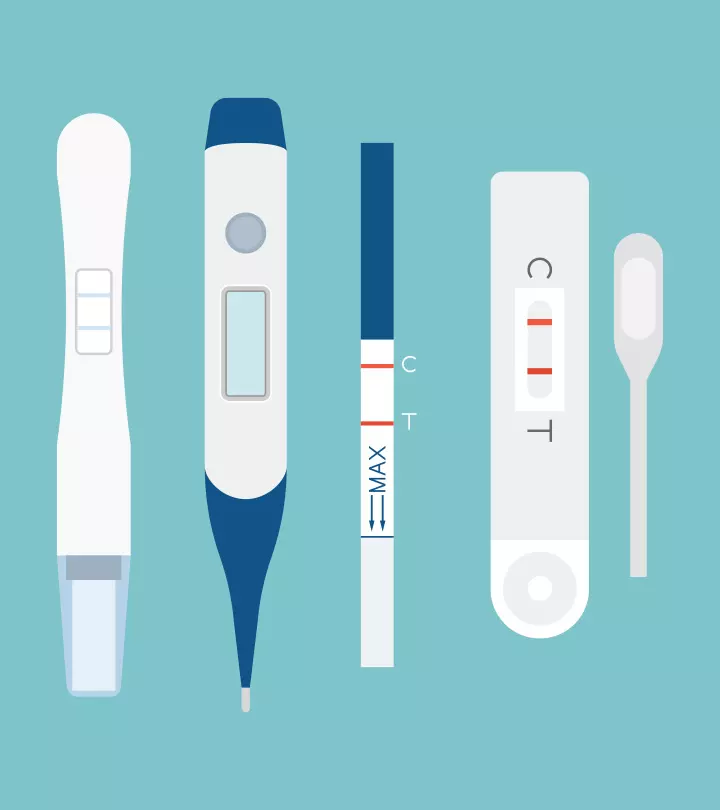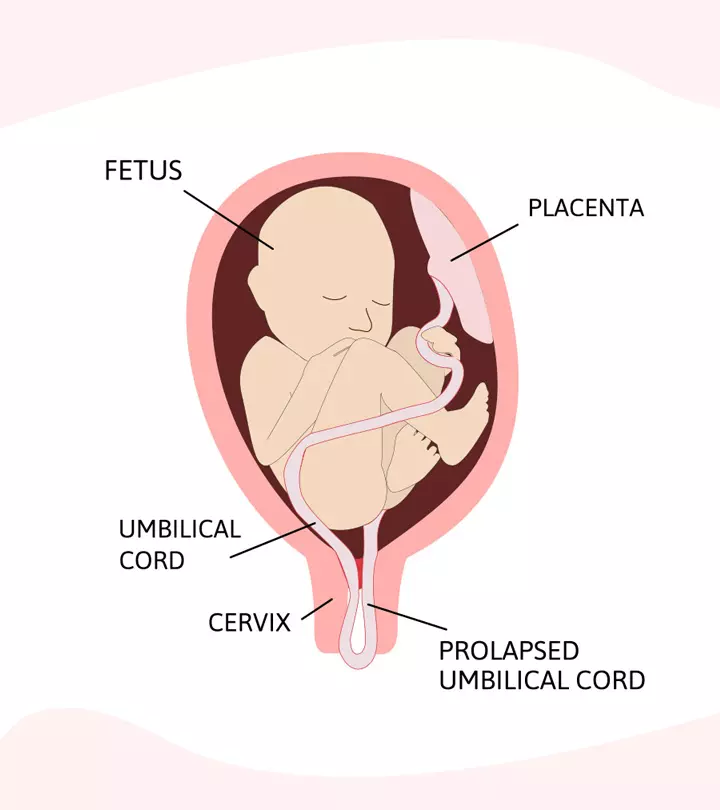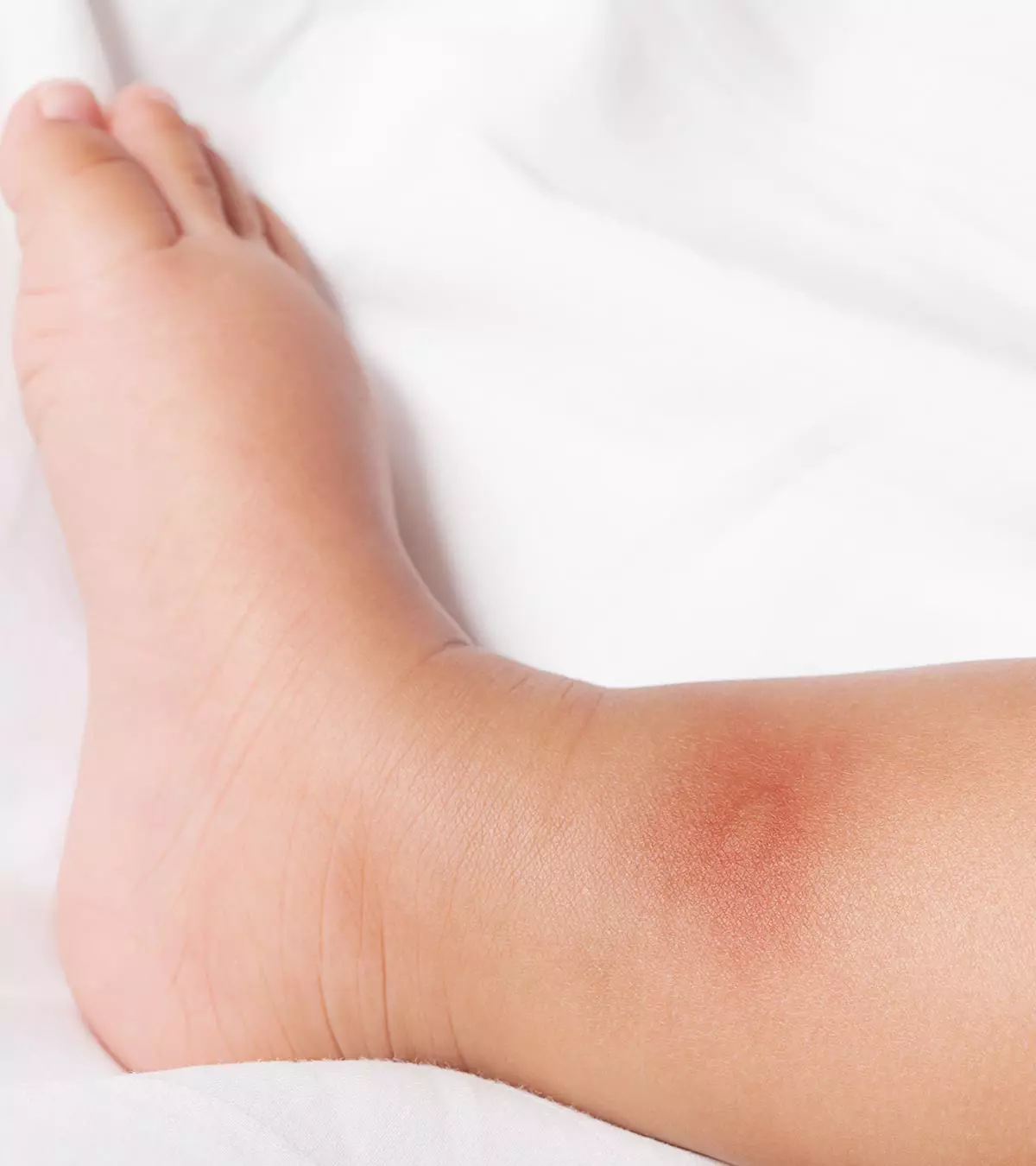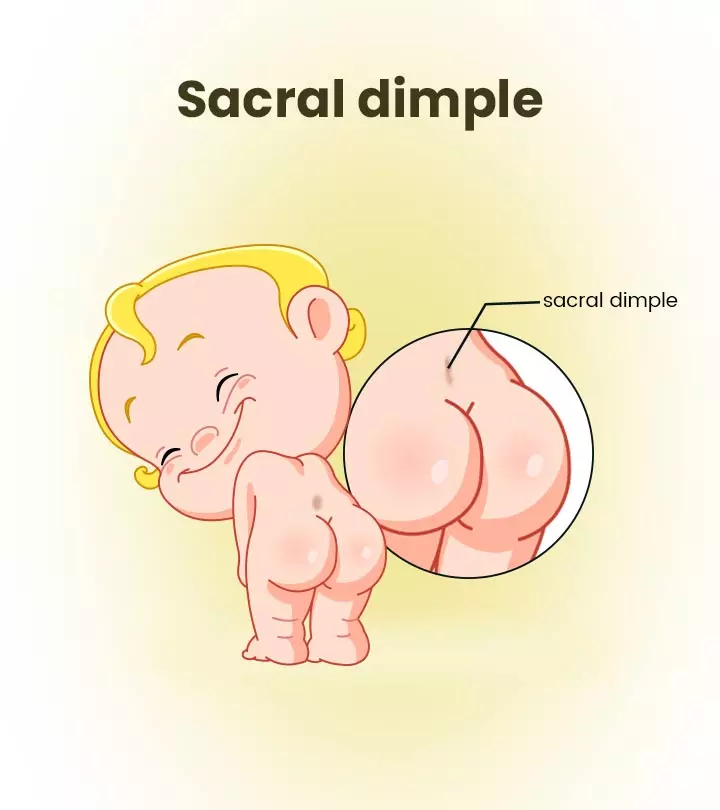
Image: MomJunction Design Team
Sacral dimples in newborns are characterized by shallow or deep indentations on the lower back (lower sacral region), just above the crease of the buttocks. They are a common cutaneous (relating to the skin) anomaly found during neonataliNewborn infant under four weeks old. spinal examinations. They are also known as sacrococcygeal or coccygeal dimples or pits. According to studies, sacral dimples are benigniLikely not harmful. and require no medical intervention (1). They are found in 1.8–7.2% of newborns and are usually detected during routine examinations (2). However, the exact cause of this congenital condition is unknown. If the sacral dimples are large, located farther from the anus, or accompanied by a turf of hair, skin tag, or skin discoloration, they might be an indication of an underlying abnormality of the spinal cord. Hence, in such cases, consult your baby’s pediatrician to check if it is a cause for concern. Read this post to learn about the reasons, types, and treatment options for sacral dimples in babies.
Key Pointers
- Sacral dimples in newborns are a common skin anomaly that has different types.
- Though usually benign, sacral dimples in some cases may indicate an underlying problem.
- Hygiene is crucial to prevent infection of typical sacral dimples, whereas the atypical ones need treatment guided by the pediatrician.
Types Of Sacral Dimples
Sacral dimples are of two types (2):
- Typical sacral dimples: These are located on the skin of the lower back, near the crease of the buttocks. Usually, you will notice no skin changes other than the shallow depression near the tailbone (coccyx) end. Typical sacral dimples are characterized by dimples that are present in the midline with <5mm in size and situated <25mm from the anus. Also, the base of the dimple can be seen.
 Quick fact
Quick fact- Atypical sacral dimples: A sacral dimple is considered atypical if dimples are not present in the midline or the size is more than 5mm in diameter, or they are situated more than 25mm from the anus, or the base of the dimple cannot be seen. the dimple is located higher up on the back or off to the side, and the bottom of the dimple may not be seen. It may also be accompanied by skin discoloration, a patch of hair, a lump, or a skin tag in babies (3).
Consult your infant’s pediatrician if you notice an atypical dimple on your baby’s body.
Symptoms Of Abnormal Sacral Dimples
Often, sacral dimples are benign and may not be a cause for concern. However, if you find the below symptoms, it could be due to an underlying medical condition (4).
- Sacral dimples accompanied by a patch of hair, a birthmark, a deviated buttock fold, or discharge
- Abnormal scan of the neonatal spinal column
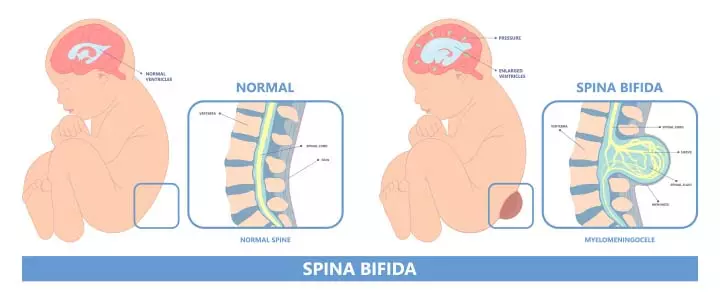
- Weakness
- Loss of sensation
- Signs of infantile scoliosisiAbnormal lateral curvature of the spine.
- Congenital dislocation of the hips
- Poor urine stream in boys
- PatulousiExpanding from the center. anal opening
Possible Complications Of Sacral Dimples
Sacral dimples are associated with complications when they belong to the atypical type. These dimples usually indicate spinal cord issues. Some of the possible problems include (3)
- Tethered spinal cord: In this condition, the spinal cord attaches to the tissue around the spine; thus, limiting the movement of the spinal cord within the spinal canal.
- Spina bifida: This is a mild condition wherein the spine doesn’t close around the spinal cord completely and remains within the spinal canal. Spina bifida may not cause any symptoms. Based on the data provided by the Centers for Disease Control and Prevention, the global incidence of such severe congenital disabilities among babies, including spina bifida, is around 3-6% yearly.
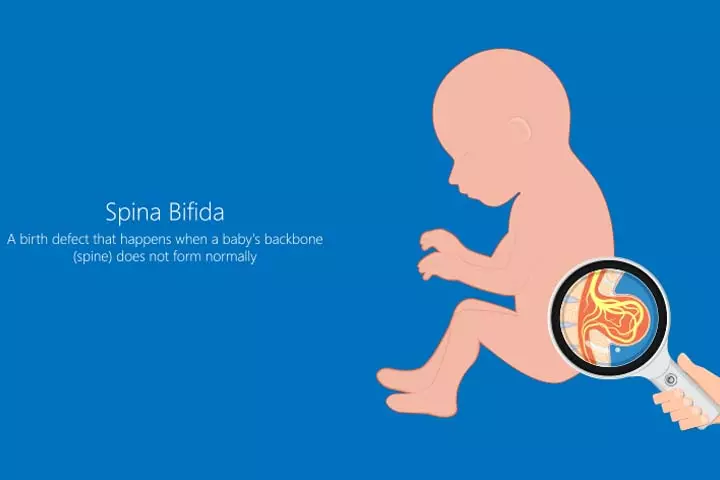
- Dermal sinus tract: This refers to an abnormal connection between the skin and spine. It can lead to infection.
Additionally, those with sacral dimples may have extra hair growth around the dimple throughout their life (5).
Diagnosis Of Sacral Dimples
Sacral dimples in newborns are usually present at birth; however, they may be identified during the routine neonatal physical examination during an 8-week checkup. If the dimple is just above the buttock or within the crease, it is considered a typical sacral dimple and does not require further investigation (10). The Royal College of Radiologists suggests, “In the newborn child, isolated midline sacral dimples and small pits can be safely ignored (2).”
However, if your doctor notices any abnormal skin changes or developmental defects near the sacrum or sacral dimple, neurological signs, dimple or pit with a maximum diameter >5mm or >2.5cm from the anus, or lesions near the pits, they might recommend the following tests to rule out spinal cord problems (10):
- Ultrasonography is considered a safe and cost-effective screening method for infants up to six weeks of age. This is because ultrasonography is a noninvasive screening technique that does not have the risk of radiation (9). If any abnormality is found, they may further refer for the MRI of the spine.
- For babies aged more than six months, the doctor may refer them to a radiologist for magnetic resonance imaging (MRI), as ultrasonography might not give accurate results of spinal conditions for older infants.
Treatment For Sacral Dimples
No specific treatment is needed if the sacral dimple is typical. However, the dimple or pit may collect dirt and sweat, which may increase the risk of an infection (5). So, try to keep the dimple area clean and avoid fecal matter from getting into it.
If your infant’s doctor diagnoses an atypical sacral dimple, they might prescribe the necessary treatment. In rare cases, surgical interventions may be needed to treat neurological issues caused by a tethered cord or other spinal abnormalities (9).
 Quick fact
Quick factFrequently Asked Questions
1. Are sacral dimples hereditary?
Some inconclusive medical research suggests that sacral dimples may have a genetic predisposition. However, more research may be needed to prove this theory (5).
2. What does an ultrasound of a sacral dimple look for?
An ultrasound is done to check for any communication between the sacral dimple and the spinal canal/vertebral column (6).
3. Do sacral dimples go away?
A sacral dimple does not go away but may become more noticeable as the baby ages (5).
4. Can babies with spina bifida move their legs?
If the baby has spina bifida lower on the spine, they may use their legs and walk using crutches, braces, or walkers. In some cases, they might be able to walk without any aid (7). However, if the baby has spina bifida higher on the spine, the baby might have paralyzed legs and need wheelchair assistance.
5. Why would a newborn need a spinal ultrasound?
Spinal ultrasound is usually requested for babies born with a sacral dimple on the lower end of their spine or tailbone to check and evaluate any spinal complication (8).
Sacral dimples in newborns are skin abnormalities that do not pose any threat to the baby’s health. However, be cautious if the condition presents with other symptoms, such as the symptoms of atypical sacral dimples. In such a case, delaying or ignoring treatment may lead to complications such as tethered spinal cord, spina bifida, and dermal sinus tract. Therefore, consult your child’s doctor to diagnose any skin abnormalities and seek appropriate and timely treatment. If the condition is deemed harmless, you need not worry but should maintain proper hygiene around the area.
Infographic: Essential Information About Sacral Dimples
There’s nothing to worry about sacral dimples. Check out this infographic as it offers a glimpse of:
- The types
- Complications
- Diagnosis
- Treatment
So you know if you should visit the doctor or not. Illustration: Momjunction Design Team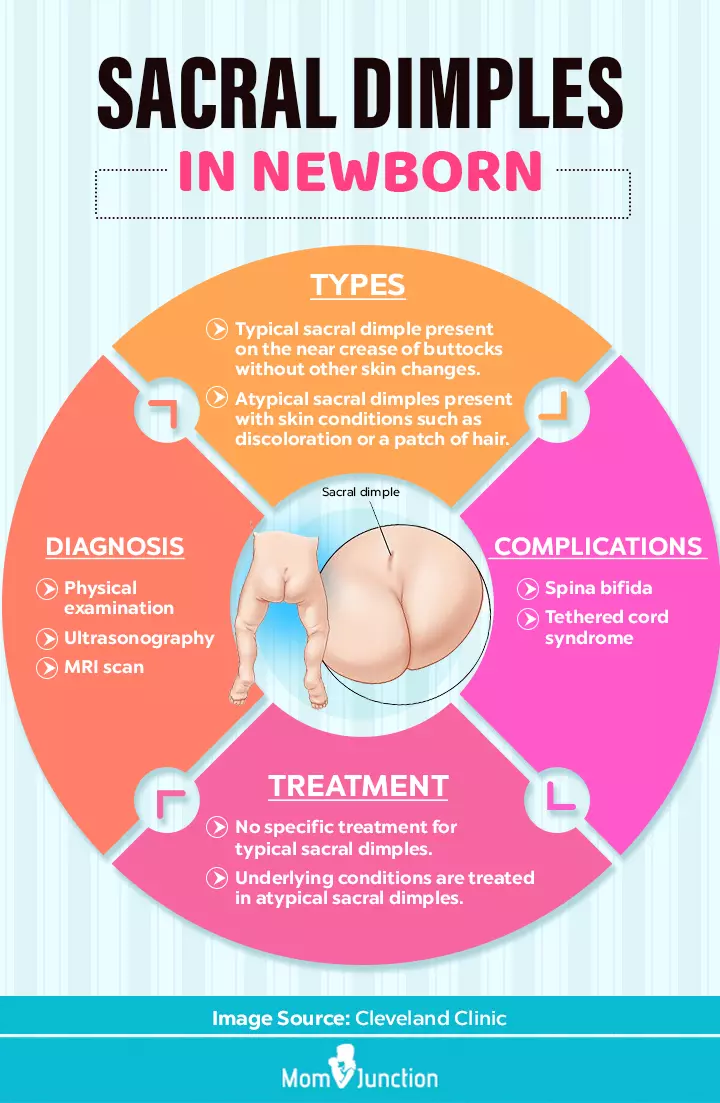
A sacral dimple is a small indentation in the lower back and is usually harmless and doesn’t require treatment. Learn more in this video!
References
1. Anselm Chi Lee, Kwong NS, and YC Wong; Management of Sacral Dimples Detected on Routine Newborn Examination: A Case Series and Review; ResearchGate (2007).
2. Sacral Dimple Neonatal Clinical Guideline V3.0; (2023); Royal Cornwall Hospitals; NHS
3. Sacral Dimple: What You Need to Know; Massachusetts General Hospital
4. Sacral Dimples or Pits; Child and Adolescent Health Service Neonatology; Government of Western Australia Child and Adolescent Health Service
5. Sacral Dimple; Cleveland Clinic
6. Sacral dimple; Radiopedia
7. Spina Bifida; CDC
8. Pediatric Spinal Ultrasound; Swedish Medical Imaging
9. Jin Hyuk Choi et al.; Outcome of ultrasonographic imaging in infants with sacral dimple; Korean Journal of Pediatrics (2018).
10. Sacral dimples and pits; NHS Bristol, North Somerset and South Gloucestershire ICB
Community Experiences
Join the conversation and become a part of our nurturing community! Share your stories, experiences, and insights to connect with fellow parents.
Read full bio of Dr. Aarti R. Motiani
Read full bio of Rohit Garoo
Read full bio of Dr. Ritika Shah
Read full bio of Anindita Ghatak









